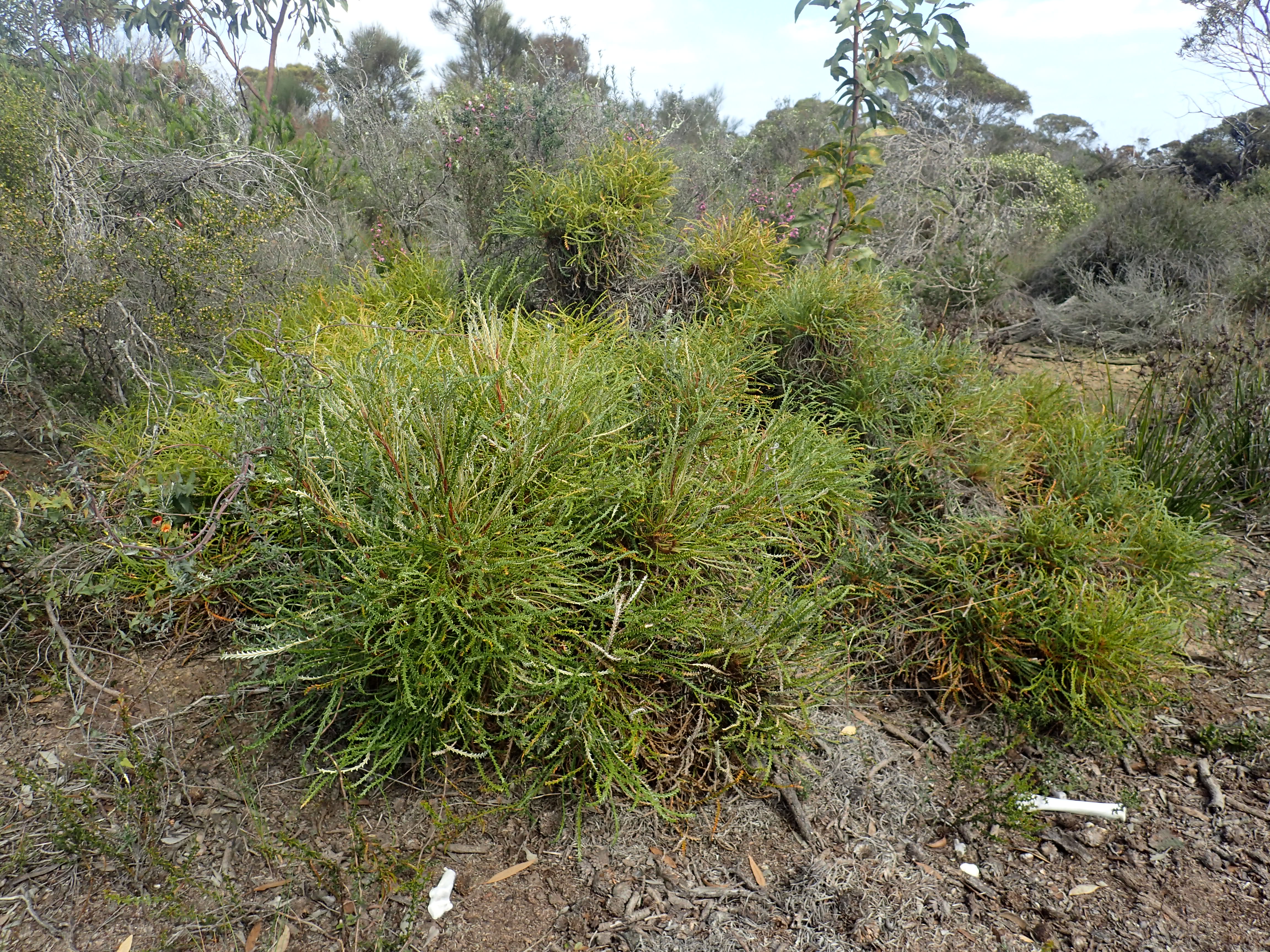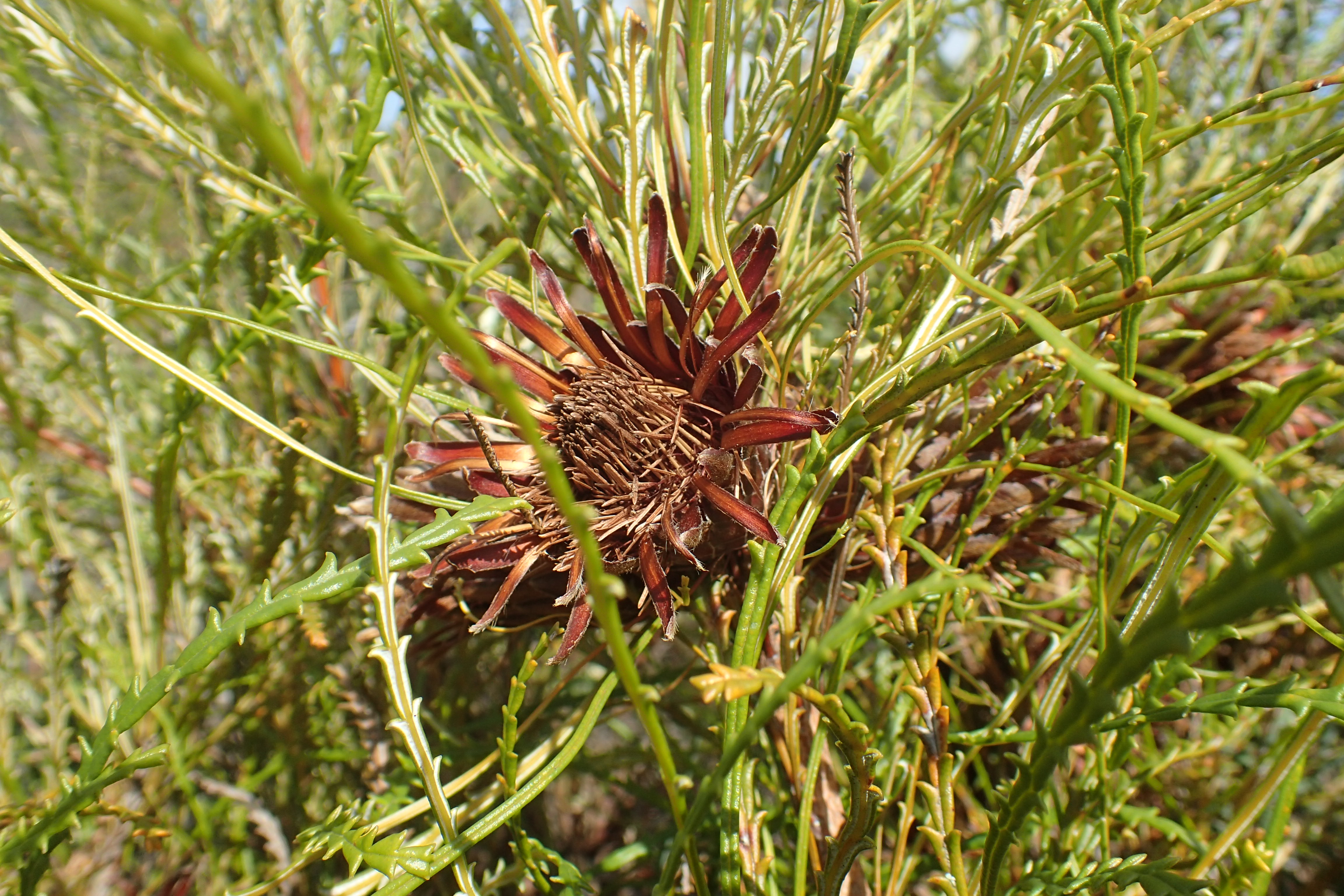Banksia Tenuis on:
[Wikipedia]
[Google]
[Amazon]

 ''Banksia tenuis'' is a species of shrub that is
''Banksia tenuis'' is a species of shrub that is

 ''Banksia tenuis'' is a species of shrub that is
''Banksia tenuis'' is a species of shrub that is endemic
Endemism is the state of a species being found in a single defined geographic location, such as an island, state, nation, country or other defined zone; organisms that are indigenous to a place are not endemic to it if they are also found else ...
to the southwest of Western Australia. It has pinnatifid
Pinnation (also called pennation) is the arrangement of feather-like or multi-divided features arising from both sides of a common axis. Pinnation occurs in biological morphology, in crystals, such as some forms of ice or metal crystals, and i ...
, serrated or smooth-edges leaves, golden brown and cream-coloured flowers in heads of about fifty-five and glabrous
Glabrousness (from the Latin '' glaber'' meaning "bald", "hairless", "shaved", "smooth") is the technical term for a lack of hair, down, setae, trichomes or other such covering. A glabrous surface may be a natural characteristic of all or part of ...
, egg-shaped follicles.
Description
''Banksia tenuis'' is a shrub that typically grows to a height of or is a mat-like shrub spreading to wide, but it does not form alignotuber
A lignotuber is a woody swelling of the root crown possessed by some plants as a protection against destruction of the plant stem, such as by fire. Other woody plants may develop basal burls as a similar survival strategy, often as a response t ...
. The leaves are linear in outline, long and wide on a petiole up to long. The leaves are curved or bent, sometimes pinnatifid or serrated with up to twenty teeth on each side, or with smooth edges. The flowers are golden brown and cream-coloured and arranged in heads of between forty-five and sixty-five with reddish brown, egg-shaped to oblong involucral bracts long at the base of the head. The perianth
The perianth (perigonium, perigon or perigone in monocots) is the non-reproductive part of the flower, and structure that forms an envelope surrounding the sexual organs, consisting of the calyx (sepals) and the corolla ( petals) or tepals when ...
is long and the pistil long. Flowering occurs from March to July and the fruit is a glabrous, egg-shaped follicle long.
Taxonomy and naming
This species was first formally described in 1810 by Robert Brown who gave it the name ''Dryandra tenuifolia'' and published the description in the ''Transactions of the Linnean Society of London
The Linnean Society of London is a learned society dedicated to the study and dissemination of information concerning natural history, evolution, and taxonomy. It possesses several important biological specimen, manuscript and literature col ...
''.
In 1996, Alex George described two varieties of ''Dryandra tenuifolia'':
* ''Dryandra tenuifolia'' var. ''reptans'', a more or less prostrate shrub with leaves that are smooth-edged, or only serrated near the tip;
* ''Dryandra tenuifolia'' var. ''tenuifolia'', a bushy, more or less erect shrub with leaves that are pinnatifid or serrated for at least most of their length.
In 2007 all ''Dryandra'' species were transferred to ''Banksia
''Banksia'' is a genus of around 170 species in the plant family Proteaceae. These Australian wildflowers and popular garden plants are easily recognised by their characteristic flower spikes, and fruiting "cones" and heads. ''Banksias'' range ...
'' by Austin Mast Austin R. Mast is a research botanist. Born in 1972, he obtained a Ph.D. from the University of Wisconsin–Madison in 2000. He is currently a professor within the Department of Biological Science at Florida State University (FSU), and has been dir ...
and Kevin Thiele
Kevin R. Thiele is currently an adjunct associate professor at the University of Western Australia and the director of Taxonomy Australia. He was the curator of the Western Australian Herbarium from 2006 to 2015. His research interests include ...
, and this species became ''Banksia tenuis'' and the varieties ''reptans'' and ''tenuis'' respectively. As the name ''Banksia tenuifolia'' had already been published in reference to the plant now known as ''Hakea sericea
''Hakea sericea'', commonly known as bushy needlewood or silky hakea, is a large shrub with a profusion of mainly white flowers from July for several months. It is endemism, endemic to eastern Australia. It has become an environmental weed in so ...
'' (needlebush), Mast and Thiele had to choose a new specific epithet; their choice, "tenuis", retains the original names' use of the Latin
Latin (, or , ) is a classical language belonging to the Italic branch of the Indo-European languages. Latin was originally a dialect spoken in the lower Tiber area (then known as Latium) around present-day Rome, but through the power of the ...
''tenuis'' ("thin"), in reference to the narrow leaves.
Distribution and habitat
''Banksia tenuis'' grows inkwongan
Kwongan is plant community found in south-western Western Australia. The name is a Bibbelmun (Noongar) Aboriginal term of wide geographical use defined by Beard (1976) as
Kwongan has replaced other terms applied by European botanists such as ...
and is widespread between Darkan, Williams and the Cape Arid National Park. The autonym
Autonym may refer to:
* Autonym, the name used by a person to refer to themselves or their language; see Exonym and endonym
* Autonym (botany), an automatically created infrageneric or infraspecific name
See also
* Nominotypical subspecies, in zo ...
, var. ''tenuis'' is found between Kamballup in the Stirling Range National Park
Stirling Range National Park is a national park in the Great Southern region of Western Australia, approximately south-east of Perth.
Description
It protects the Stirling Ranges, or Koikyennuruff, a range of mountains and hills over wide fr ...
and Cape Arid, and var. ''reptans'' between Darkan, Williams and Jerramungup.
Ecology
An assessment of the potential impact ofclimate change
In common usage, climate change describes global warming—the ongoing increase in global average temperature—and its effects on Earth's climate system. Climate change in a broader sense also includes previous long-term changes to ...
on this species found that its range is likely to contract by between 30% and 80% by 2080, depending on the severity of the change.
Conservation status
''Banksia tenuis'' and both varieties of the species are classified as "not threatened" by the Western Australian GovernmentDepartment of Parks and Wildlife
The Department of Parks and Wildlife (DPaW) was the department of the Government of Western Australia responsible for managing lands described in the ''Conservation and Land Management Act 1984'' and implementing the state's conservation and e ...
.
References
* {{Taxonbar, from=Q4856748 tenuis Plants described in 1810 Taxa named by Robert Brown (botanist, born 1773)